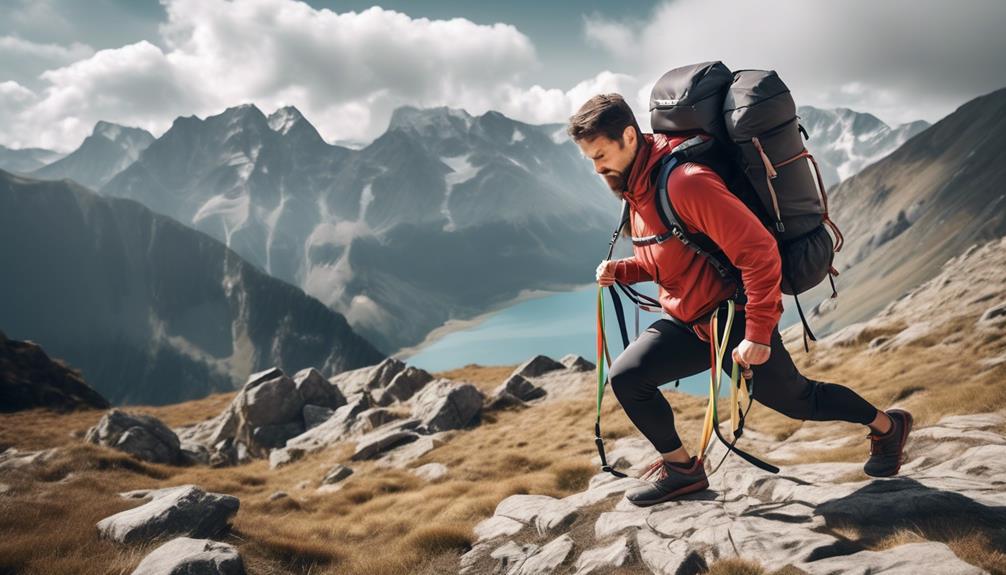Mastering High Altitude Mountain Trekking Training
Imagine standing on a rugged mountain ridge, surrounded by towering peaks and a crisp, thin air that fills your lungs. You're preparing to embark on a high altitude trek, where the challenges are as breathtaking as the views.
As you navigate the demanding terrain, mastering high altitude mountain trekking training is essential to ensure your safety, enjoyment, and success in this awe-inspiring environment. From acclimatization techniques to mental resilience, each aspect of your preparation is crucial to your experience.
So, let's explore the key elements that will help you conquer the heights and achieve your trekking goals.
Understanding High Altitude Effects
To prepare for high altitude mountain trekking, it's essential to understand the effects that altitude can have on the body. As you ascend to higher elevations, the oxygen levels in the air decrease. This decrease in oxygen can have a significant impact on your physical performance. With reduced oxygen levels, your body has to work harder to supply enough oxygen to the muscles and organs. This can lead to symptoms such as shortness of breath, fatigue, and dizziness, making physical exertion more challenging.
The decrease in oxygen levels at higher altitudes can also affect your aerobic capacity, or the ability of your body to use oxygen during exercise. This means that even simple activities like walking uphill can feel more strenuous than at lower elevations. It's important to be aware of these effects so that you can prepare both mentally and physically for the challenges of high altitude trekking.
Understanding the impact of altitude on physical performance is crucial for planning your training and acclimatization. By gradually increasing your exposure to higher altitudes, you can help your body adapt to the lower oxygen levels. Additionally, incorporating specific training techniques such as interval training and aerobic exercises can improve your body's ability to cope with reduced oxygen, ultimately enhancing your performance at high altitudes.
Cardiovascular Endurance Training
As you prepare for high altitude mountain trekking, building cardiovascular endurance becomes crucial for acclimatizing to lower oxygen levels and enhancing your physical performance. High-Intensity Interval Training (HIIT) workouts are highly effective in improving cardiovascular endurance and preparing your body for the demands of high altitude trekking.
HIIT involves short bursts of intense exercise followed by brief recovery periods, helping to improve your heart's ability to pump blood and oxygen more efficiently, which is essential when dealing with reduced oxygen levels at higher altitudes. Additionally, incorporating long distance running into your training regimen is beneficial for adapting to lower oxygen levels.
This form of endurance training helps your body become more efficient at utilizing oxygen, which is vital for sustained performance at high altitudes.
To enhance your cardiovascular endurance for high altitude mountain trekking, consider the following training techniques:
- HIIT Workouts at Altitude: Incorporate HIIT workouts into your training routine, gradually increasing the intensity and duration to simulate the cardiovascular demands you'll face at higher altitudes.
- Long Distance Running: Engage in regular long distance running sessions to improve your body's oxygen utilization, helping you adapt to the lower oxygen levels experienced at high altitudes.
- Interval Training: Introduce interval training into your cardiovascular endurance workouts, alternating between periods of high intensity and active recovery to improve your overall endurance and oxygen utilization.
Strength and Resistance Training

Consider incorporating compound movements such as squats and deadlifts into your training regimen to build strength and resistance for high altitude mountain trekking. Weight lifting is an essential component of strength training as it helps in developing the muscles needed for carrying heavy loads and navigating challenging terrain. When engaging in weight lifting, focus on exercises that target multiple muscle groups simultaneously, such as bench presses, lunges, and overhead presses. These compound movements not only enhance overall strength but also improve coordination and stability, which are crucial for mountain trekking.
In addition to weight lifting, body resistance exercises are equally important for building functional strength. These exercises utilize your body weight as resistance, and they're highly effective in improving muscular endurance and stamina. Incorporate body resistance exercises like push-ups, pull-ups, planks, and burpees into your training routine to strengthen the muscles that are heavily engaged during mountain trekking, such as the core, arms, and shoulders.
To maximize the benefits of strength and resistance training, aim for a well-rounded program that includes both weight lifting and body resistance exercises. It's important to gradually increase the intensity and difficulty of your workouts over time to continuously challenge your muscles and promote growth. By incorporating these training methods into your regimen, you'll be better prepared to tackle the physical demands of high altitude mountain trekking.
Altitude Acclimatization Techniques
Incorporating altitude acclimatization techniques into your training regimen is essential for preparing your body to adapt to the decreased oxygen levels at high elevations, a crucial aspect of high altitude mountain trekking.
Here are some effective techniques to help you acclimatize to high altitudes:
- Breathing exercises: Practice deep breathing exercises to improve your lung capacity and oxygen efficiency. Focus on inhaling deeply through your nose and exhaling slowly through your mouth. This can help optimize your body's oxygen uptake and utilization, which is vital at higher altitudes.
- Hypoxic training: Utilize hypoxic training methods, such as using altitude simulation masks or training in hypoxic chambers. These techniques expose your body to reduced oxygen levels, stimulating physiological adaptations that can enhance your ability to function at high altitudes. Gradually increasing the intensity and duration of hypoxic training sessions can significantly improve your body's tolerance to lower oxygen levels.
- Progressive altitude exposure: If possible, incorporate gradual exposure to higher altitudes into your training. This could involve starting your trek at a lower elevation and gradually ascending to higher altitudes over several days. This approach allows your body to acclimatize naturally and can reduce the risk of altitude-related illnesses.
Nutrition and Hydration Strategies

To optimize your performance during high altitude mountain trekking, it's crucial to carefully consider your nutrition and hydration strategies. Adequate hydration is essential for combating the effects of high altitude. It's recommended to drink 3-4 liters of water per day, and even more if you're exerting yourself. In addition to water, electrolyte balance is crucial. Consider consuming sports drinks or electrolyte tablets to replenish the minerals lost through sweating and help prevent conditions like hyponatremia.
Nutrient timing and meal planning are also vital components of your nutrition strategy. Aim to consume small, frequent meals to maintain energy levels and aid digestion, as high altitudes can suppress appetite. Carbohydrates are your body's primary energy source, so ensure your meals are rich in complex carbs like whole grains, fruits, and vegetables. Additionally, including lean proteins and healthy fats in your meals can support muscle recovery and keep you feeling satiated.
When planning your meals, take into account the limited cooking facilities and the weight of the food you'll be carrying. Consider nutrient-dense, lightweight options such as dehydrated meals, nuts, seeds, and energy bars. It's also beneficial to start increasing your calorie intake a few days before the trek to build up energy reserves.
Gear and Equipment Essentials
For high altitude mountain trekking, sturdy hiking boots with ankle support are crucial gear to protect your feet and provide stability on rugged terrain. Ensuring the right gear selection and equipment maintenance is essential for a successful trek. Here are some packing essentials and gear technology tips to consider:
- Layered Clothing: High altitude trekking requires clothing that can adapt to changing weather conditions. Invest in moisture-wicking base layers, insulating mid-layers, and waterproof outer layers to stay comfortable and protected from the elements.
- Technical Backpack: A well-designed backpack with adjustable straps and padding is crucial for distributing weight evenly and reducing strain on your back. Look for a backpack with multiple compartments for organized packing and easy access to essentials.
- Navigation Tools: Equip yourself with a reliable GPS device or map and compass for navigation. High-tech GPS devices offer advanced features like preloaded maps, waypoint marking, and altitude readings, while traditional navigation tools serve as reliable backups in case of technology failure.
When preparing for high altitude mountain trekking, gear technology can greatly enhance your experience, but it's equally important to invest time in equipment maintenance. Regularly check and maintain your gear to ensure it's in optimal condition for the trek.
Mental Preparation and Resilience

Mentally preparing for high altitude mountain trekking requires developing resilience and a strong mindset to overcome the physical and mental challenges of the journey. Mindset development is essential for navigating the demanding terrain, unpredictable weather, and extended periods of isolation. It's crucial to cultivate emotional strength and mental toughness to cope with the stress and anxiety that can arise during the trek.
To develop the necessary mindset for high altitude trekking, it's important to practice stress management techniques. Learning how to control your breathing, staying focused on the present moment, and using positive self-talk can help you stay calm and composed in challenging situations. Additionally, mental toughness plays a significant role in overcoming obstacles. This involves embracing discomfort, pushing through fatigue, and maintaining a resilient attitude when faced with adversity.
It's also essential to recognize the importance of mental preparation alongside physical training. Visualizing successful outcomes, setting achievable goals, and preparing for potential setbacks can contribute to a more resilient mindset. Embracing the journey with an open and adaptable attitude can help manage expectations and reduce the impact of unexpected challenges.
Safety and Emergency Protocols
Develop a thorough understanding of safety and emergency protocols to ensure your preparedness for any unforeseen circumstances during high altitude mountain trekking. Safety measures are crucial to mitigate risks and respond effectively in case of emergencies. Here are some essential considerations to prioritize safety and emergency response:
- Emergency Response Plan: Familiarize yourself with the emergency response plan of the trekking route or expedition. Understand the communication and evacuation procedures in case of accidents or medical emergencies. Carry a satellite phone or emergency beacon for communication in remote areas where cell reception is unavailable.
- First Aid Training: Equip yourself with basic first aid knowledge and training. Learn how to manage altitude sickness, frostbite, and other common high-altitude injuries. Carry a well-stocked first aid kit and medications suitable for high altitude trekking.
- Weather Monitoring: Stay informed about the weather conditions and forecasts for the trekking area. Sudden changes in weather can pose significant risks, including avalanches, storms, and extreme cold. Be prepared to alter your plans or take shelter if unexpected weather patterns arise.
Frequently Asked Questions
What Are the Best Ways to Prevent and Treat High Altitude Sickness?
To prevent and treat high altitude sickness, focus on altitude acclimatization and stay hydrated. Medication and oxygen therapy can also help. Take it easy and listen to your body. Don't push too hard too soon.
How Should I Adjust My Training Routine if I Have a Pre-Existing Cardiovascular Condition?
You should prioritize cardiovascular safety when adjusting your fitness routine for altitude training. Consult a doctor for guidance on high altitude medication and a tailored training plan to ensure your pre-existing condition is managed effectively.
Are There Specific Exercises I Can Do to Strengthen My Legs for High Altitude Trekking?
To strengthen your legs for high altitude trekking, focus on exercises like squats, lunges, and calf raises for endurance training. Also, prioritize altitude-specific nutrition and hydration strategies to support your training and trekking efforts.
What Are Some Advanced Techniques for Acclimatizing to High Altitude More Quickly?
To acclimate to high altitude more quickly, try advanced breathing techniques like hypoxic tents or altitude training masks. Consider altitude medication to support your adjustment. These methods can help you prepare for challenging treks at high altitudes.
How Can I Ensure I Am Getting Enough Calories and Nutrients at High Altitude Without Carrying Excessive Weight in My Pack?
To ensure you're getting enough calories and nutrients at high altitude without carrying excessive weight, pack nutrient-dense snacks like nuts and dried fruits, and focus on lightweight meal planning. Use hydration strategies and opt for portable nutrition options.
Conclusion
You've learned the essential components of mastering high altitude mountain trekking training.
By understanding the effects of high altitude, training your cardiovascular endurance and strength, acclimatizing to altitude, and focusing on nutrition, gear, and mental preparation, you're well-equipped for the challenges ahead.
Remember to prioritize safety and emergency protocols, and you'll be ready to conquer the mountains with confidence and resilience.
Keep pushing yourself and enjoy the incredible journey ahead!
